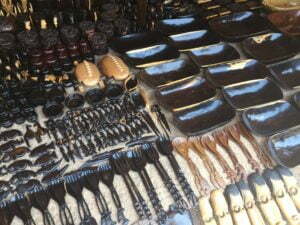
Art is not only something that hangs in museums and galleries. Around the world, art is abundant and in the streets; it is the zest on gray city walls, and it is held in the hands of a side-of-the-road sculptor. It is often easy and and not thought about too much— effortlessly created in the same way that a mother sings a lullaby: not to win a Grammy, but to share love and connect.
In my years in the Paris art scene, I became accustomed to two worlds: sumptuous art fairs synonymous with champagne and international influencers, and cold artists’ studios where the will to create had to overcome both wintery chill and the burden of anonymity.
But in other parts of the world, far away from art critics and competitive prizes, the value of art lies in its ability to resonate, not innovate. Travelling through Africa and South America, India and Indonesia, it seemed that I was discovering a new kind of art. In rural African villages, I saw men sit in the shade along dirt roads, carving away at figurines from local timber. Beside them lay 20-30 accomplished pieces for sale. Stylistically, they were no different than the ones I had seen another man, another day make. And yet they were full of life, attractive and nuanced enough for a single piece to stand out and catch my eye.

Of all the artworks I brought home from Africa, my favorite remains a set of two ebony figures, a man and a woman, that I traded for a pen. I chose them on a whim because it was the artist who offered the exchange as I passed by. Free from concern over the fairness of the price, potential of being scammed, or hesitance to spend money on (even more) art, I was able to choose them with absolute freedom. Filled with delight, I looked over all of my options until I picked up the ones that attracted my attention the most. It was a deal, and for months to come they lay nestled between my clothes as I explored continents and flew across oceans.
Though I didn’t realize it at the time, that set of woodcarvings has come to represent my partnership with my husband and the roots of where we met. They maintain value because each time I see them, I invest meaning into them. I see a story; I see my story. And yet, when I look at them closely, at each chisel mark and color variation, I always hope to see something new and not yet familiar.
*TOP IMAGE: George Obeng, a wood carver from Ghana. Image and video credits, NOVICA